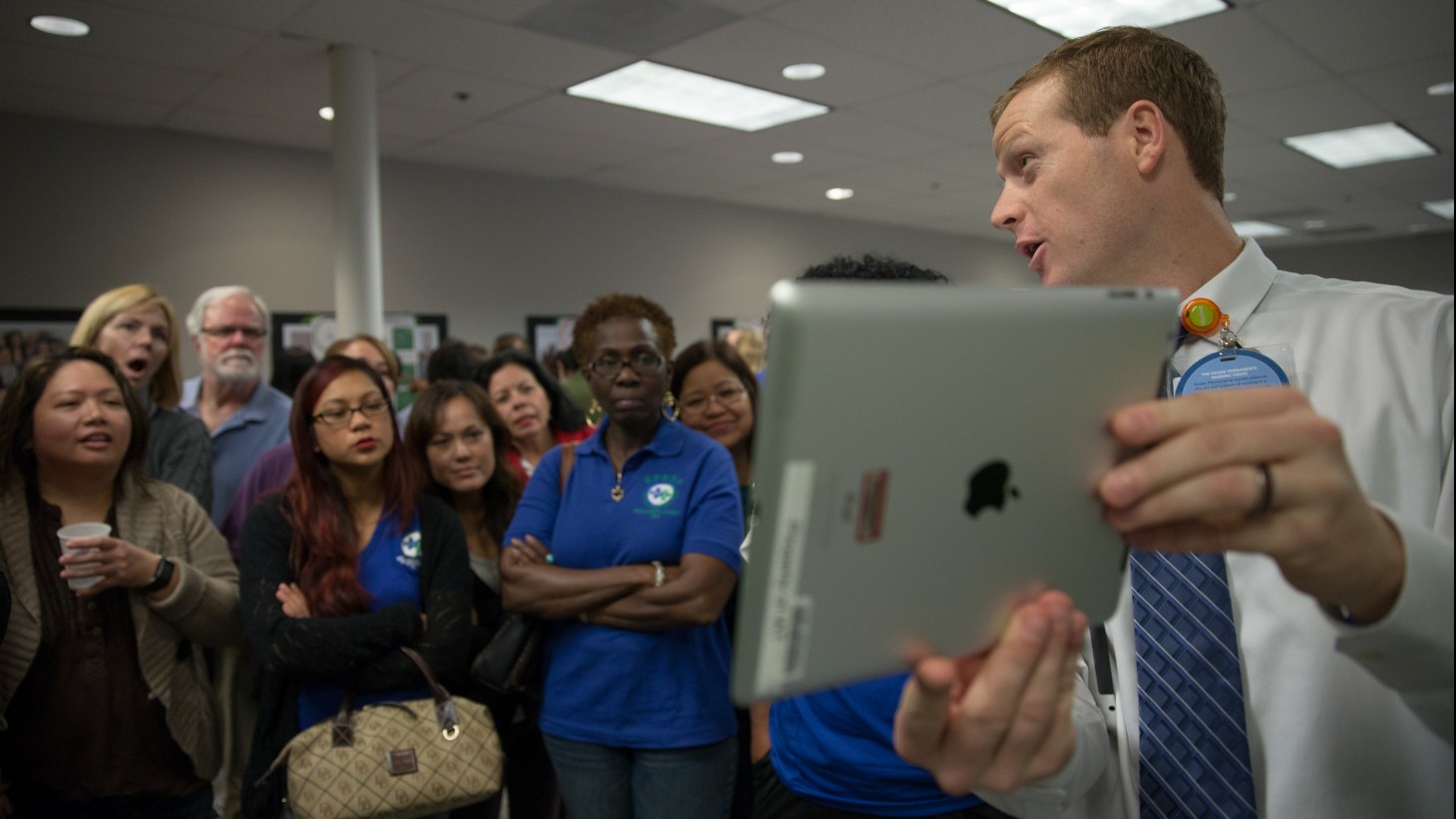Hank Spring 2014
Peer Advice: Imagining Care Anywhere

Dan Weberg demonstrates to a group of nurses at a UNAC/UHCP steward meeting how electronics may change care delivery.
Technology may change care delivery
The Imagining Care Anywhere exhibit, created by Kaiser Permanente’s Innovation and Advanced Technology team and the Garfield Innovation Center, illustrates how current and emerging technology makes it possible to bring health care directly to a patient’s home—or wherever a member may be—and can transform the way care is delivered at the doctor’s office and in the hospital. Dan Weberg is director of nursing innovation at the Garfield center and has been traveling to Kaiser Permanente facilities, conferences and union meetings to talk with people at all levels of the organization about the exhibit. He was interviewed by LMP Communications Director Andrea Buffa.
Q. As director of nursing innovation, what kind of work do you do?
A. I have a really great job. I’m supposed to help envision the future about three to five years from now and figure out what technologies, what trends, what changes in nursing practices and what changes in health care might occur. And then help guide pilot projects and strategy and brainstorming sessions to move the organization toward that future.
Q. What is the Imagining Care Anywhere exhibit about?
A. Imagining Care Anywhere is the start of a conversation with everyone at Kaiser Permanente to create a vision of what it might look like in the future as we engage members no matter where they are. How can we seamlessly integrate their home life, their school life, their work life and their health interactions with Kaiser all together? How can we help people have a more healthy lifestyle or healthy work-life balance? It’s a tour that’s supposed to provoke people to think about and imagine what that care will look like.
Q. How are emerging technologies changing the future of health care?
A. One example is the smartphone. Many of us use it for everything from tracking our fitness goals to shopping lists to emails to Facebook. But the data and the information behind that can be integrated in with goals for your health life. We’re working on a project now called Profile and Preferences. You might be able to set personal health goals and then use the data you collect already—whether it’s through a fitness app or diet tracking—and upload that into your kp.org profile so you can see how you’re moving along with your goals. And then, when you meet with your care team, we have a better picture of who you are as a person, and we can help you facilitate your goals. Remote diagnostics and remote monitoring are a big deal now, too.
Q. What do you think virtual visits will look like?
A. There are several organizations now that do tele-visits, including Kaiser. I think the future is going to hold more of these as our TVs and our cable providers get faster and faster internet and smarter devices. It may not be a full visit, but it may be a way to engage with a care provider—whether it’s a nurse, a physician, some sort of navigator or a health coach. Keeping people from having to drive into one of our facilities for simple things is going to be key.
Q. How are things going to be different when people are in the hospital?
A. In the exhibit, there’s a “journey home” board, which allows members to know exactly what has to happen before they get discharged. They don’t have to continue asking the nurse or the doctor or the care team by clicking the call light—they can see it right there and they’re able to access it.
The board is also about answering their questions conveniently and in a way they can understand. The exhibit has the idea of using an avatar. After a nurse or teacher comes in to do some kind of education, the member still has some questions. Instead of having to ask the same questions over and over and feeling a little uncomfortable, they’re able to use a virtual person to answer them.
Q. How can KP support its employees and help them advance their careers as these changes begin to take place?
A. I think as an institution we need to keep thinking about how we evolve our roles, what are the things we need to do differently. The technology is coming whether we want it or not, so it’s about continuing to imagine how specific roles might change and coming up with strategies to train our workforce to be able to evolve with the technology.
Q. What role are the labor unions that represent KP’s employees playing?
A. We’re really excited about the engagement with the unions. I think it’s great that they’re using Imagining Care Anywhere as a springboard to talk to their constituents about how the future of health care is going to evolve and also work to create that future with us.
The front line should be driving this because they know what’s broken. And they can help us address that early, before we get too far down the road with a solution that may not meet the real need.
